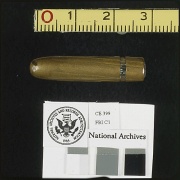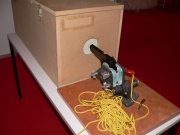Difference between revisions of "Ballistics"
m (1 revision) |
m |
||
| (One intermediate revision by one user not shown) | |||
| Line 32: | Line 32: | ||
== See also == | == See also == | ||
| + | * [[Aberdeen Chronograph]] | ||
| + | * [[Association of Firearm and Tool Mark Examiners]] | ||
* [[Ballistic fingerprinting]] | * [[Ballistic fingerprinting]] | ||
| + | * [[Ballistic limit]] | ||
* [[Bullet]] | * [[Bullet]] | ||
* [[Cartridge]] | * [[Cartridge]] | ||
| + | * [[Comparison microscope]] | ||
* [[Gun]] | * [[Gun]] | ||
| + | * [[Gunshot injury]] | ||
| + | * [[Gunshot residue]] | ||
| + | * [[Hydrostatic shock]] | ||
* [[Physics of firearms]] | * [[Physics of firearms]] | ||
| + | * [[Stopping Power]] | ||
* [[Trajectory]] | * [[Trajectory]] | ||
* [[Vaporific Effect]] | * [[Vaporific Effect]] | ||
| − | |||
| − | |||
| − | |||
==References== | ==References== | ||
| Line 56: | Line 61: | ||
| − | [[Category:Ballistics]] | + | [[Category:Ballistics| ]] |
Latest revision as of 11:54, 21 September 2013
Ballistics (Greek βάλλειν ('ba'llein'), "throw") is the science of mechanics that deals with the motion, behavior, and effects of projectiles, especially bullets, gravity bombs, rockets, or the like; the science or art of designing and accelerating projectiles so as to achieve a desired performance.
A ballistic body is a body which is free to move, behave, and be modified in appearance, contour, or texture by ambient conditions, substances, or forces, as by the pressure of gases in a gun, by rifling in a barrel, by gravity, by temperature, or by air particles. A ballistic missile is a missile designed to operate in accordance with the laws of ballistics.
In the field of forensic science, forensic ballistics is the science of analyzing firearm usage in crimes.
[edit] Gun ballistics
Gun ballistics is the study of projectiles from the time of firing to the time of impact with the target. Gun ballistics is often broken down into the following four categories, which contain detailed information on each category:[1]
- Internal ballistics, the study of the processes originally accelerating the projectile, for example the passage of a bullet through the barrel of a rifle;
- Transition ballistics, (sometimes called intermediate ballistics) the study of the projectile's behavior when it leaves the barrel and the pressure behind the projectile is equalized.
- External ballistics, the study of the passage of the projectile through space or the air; and
- Terminal ballistics, the study of the interaction of a projectile with its target, whether that be flesh (for a hunting bullet), steel (for an anti-tank round), or even furnace slag (for an industrial slag disruptor).
[edit] Forensic ballistics

Forensic ballistics involves analysis of bullets and bullet impacts to determine the type. Separately from ballistics information, firearm and tool mark examinations involve analyzing firearm, ammunition, and tool mark evidence in order to establish whether a certain firearm or tool was used in the commission of a crime.
Rifling, which first made an appearance in the 15th century, is the process of making grooves in gun barrels that imparts a spin to the projectile for increased accuracy and range. Bullets fired from rifled weapons acquire a distinct signature of grooves, scratches, and indentations which are somewhat unique to the weapon used.
The first firearms evidence identification can be traced back to England in 1835 when the unique markings on a bullet taken from a victim were matched with a bullet mold belonging to the suspect. When confronted with the damning evidence, the suspect confessed to the crime.
The first court case involving firearms evidence took place in 1902 when a specific gun was proven to be the murder weapon. The expert in the case, Oliver Wendell Holmes, had read about firearm identification, and had a gunsmith test-fire the alleged murder weapon into a wad of cotton wool. A magnifying glass was used to match the bullet from the victim with the test bullet.
Calvin Goddard, physician and ex-army officer, acquired data from all known gun manufacturers in order to develop a comprehensive database. With his partner, Charles Waite, he catalogued the results of test-firings from every type of handgun made by 12 manufacturers. Waite also invented the comparison microscope. With this instrument, two bullets could be laid adjacent to one another for comparative examination.
In 1925 Goddard wrote an article for the Army Ordnance titled "Forensic Ballistics" in which he described the use of the comparison microscope regarding firearms investigations. He is generally credited with the conception of the term "forensic ballistics," though he later admitted it to be an inadequate name for the science.
In 1929 the St. Valentine's Day Massacre led to the opening of the first independent scientific crime detection laboratory in the United States.
[edit] See also
- Aberdeen Chronograph
- Association of Firearm and Tool Mark Examiners
- Ballistic fingerprinting
- Ballistic limit
- Bullet
- Cartridge
- Comparison microscope
- Gun
- Gunshot injury
- Gunshot residue
- Hydrostatic shock
- Physics of firearms
- Stopping Power
- Trajectory
- Vaporific Effect
[edit] References
- ↑ FM 6-40 Tactics, Techniques, and Procedures for Field Artillery Manual Cannonry U.S. Marine Corps, Department of the Army, 1996
[edit] External links
- Ballistic Trajectories by Jeff Bryant, The Wolfram Demonstrations Project.
[edit] Ballistic comparison
- Ballistic Chart
- AmmoGuide
- Federal Cartridge
- JBM Small Arms Ballistics — Trajectory and related calculators
